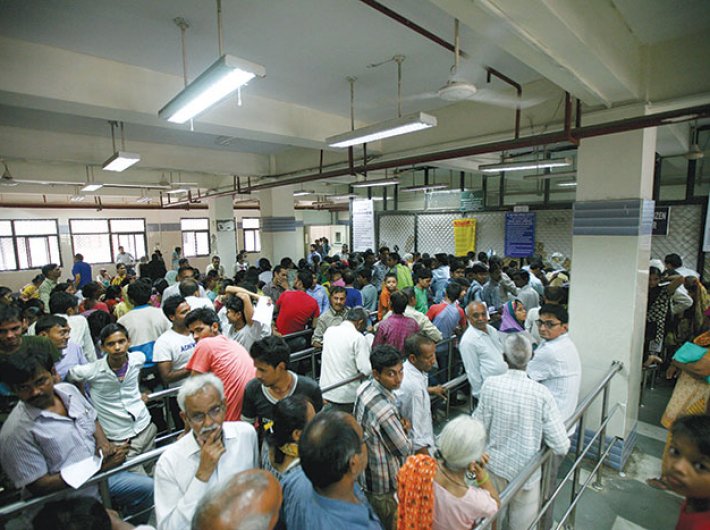Then, people won’t have to lug around medical records and policy makers will now know about diseases in real time. But there are down sides too
Imagine a scenario where a doctor knows all about the patient’s health even before being bombarded with a litany of health woes. In the not too distant future, this is going to happen in India when an electronic health record will be maintained for every Indian.
The government is planning to make a digital repository of medical history of everyone as it wants to ensure an ‘accessible, affordable and high quality’ healthcare. The initiative is in line with the global shift towards electronic health system – wherein each hospital department is computerised and networked and has a central database of patient records.
The objective, said a senior official associated with the ministry of health and family welfare, is to create an Aadhaar-linked electronic health record, EHR, for each of the 128 crore Indians. An EHR, according to the ministry, is a computerised health record used to capture, store, access and share summary information for a patient between healthcare organisations and providers.
READ: Plenty of plans but little achievement so far
The idea of the EHR is that once people have it, they will not have to carry their medical record – doctors’ prescriptions and test reports, among others – in paper format and a doctor will be able to access the entire history on the computer. The database thus created at the national level will be very crucial for the government as it would virtually give real-time access to information pertaining to diseases, procedures, medicines, for each hospital across the country. The service providers, including hospitals and insurance companies, too may have limited or full access, but the government is yet to decide about it.
As a first step, the government plans to introduce a bill in parliament to set up a regulatory cum standard setting body to promote information and communication technologies usage in public and private healthcare systems. The goal, according to the ministry of health, of the proposed National e-Health Authority [NEHA] is to ensure “development and promotion of e-health ecosystem” to provide “effective people-centred health services to all in an efficient, cost effective and transparent manner”.
The Indian health sector, excluding drugs, is largely unregulated. Due to the lack of resources and infrastructure, the public health system is in a shambles, forcing over 60 percent of patients to rely on private healthcare. Private hospitals are, however, prohibitively expensive. The government spending on health is 30 percent of the overall health expenditure. (It is 48 percent in the US and in China it is 55 percent.)
According to BP Sharma, secretary, health ministry, the resources and infrastructure gap can’t be addressed overnight and hence “information technology can serve our need in the meanwhile”.
“It’s not that we are not using IT,” Sharma said. “There are a whole host of programmes where we are using it. But the information is not flowing within the ministry, from one sector [read division] to another. They are all in silos,” he said during a consultation on the National e-Health Authority, on April 4 at AIIMS, Delhi.
“Then you have private hospitals which have their own IT system. The data is not flowing from one hospital to another. When a patient goes from one hospital to another, he has to keep the entire record with him. This is where EHR will be of great help,” Sharma said. He hoped that when a few health facilities complete computerisation, complying with revised EHR standards which were put out in March, they will start creating digital health records by the end of this year.
To thrash out privacy and security related issues with the electronic health record and prepare a draft legislation, the ministry has roped in the National Law University, Bengaluru. They signed a memorandum of understanding in February. “The NLU would prepare a model law, which would protect health record, regulate medical establishment and fix their accountability in dealing with patient data,” said another official who is aware of the matter.
At present, the NLU is looking at the constitutional aspects, especially the 7th schedule which provides the bifurcation of the central and state subjects, the senior official said. (Health is a state subject.)
The ministry has given NLU seven months to finish the job. In the meantime, the ministry will prepare a cabinet note for its approval, the senior official said.
The jury, however, is still out on the nature of the proposed body: whether it will be a regulatory body, if it will have teeth for enforcement, or if it will be a mere coordinating agency. “Since health is a state subject, to get anything done in the sector states have to be brought on board. Ideally, NEHA through its regulations should ensure compliance from states,” the senior health ministry official said.
EHR, as and when it comes, will be a win-win for people, government and service providers, noted health sector experts.
Benefits of digital health record
Firstly, the EHR will streamline the interaction between doctors and patients. Since hospitals and clinicians will have to follow standards while feeding patient information into the computer system, it will lead to “structured clinical documentation”, said Arvind Sivaramakrishnan, chief information officer, Apollo Hospitals. The EHR software will also have a column for medicines which lead to allergic reaction in a patient. So now when a doctor is prescribing new medication, she or he will know about the allergy triggering medicines, even if the patient forgets to mention it.
EHR ensures codification of each disease or medical situation, required medication and related clinical procedures. “For example in Tamil Nadu – which has automated its hospitals and maintains patient record electronically – the software gives options to doctors what medicine to prescribe depending on the disease a patient has,” said S Ramakrishnan, former director general, Centre for Development of Advanced Computing (CDAC) and a member of the committee to review comments on the first draft of a paper on NEHA in 2015. He was also a member of the National Knowledge Commission’s working group on health information system, which for the first time proposed EHR for every citizen and a regulatory agency in 2008-09.
The patients also will not have to carry their entire medical record while going from one hospital to another. The electronic health proponents believe that EHR may also discourage doctors from prescribing again a test that was done recently.
Secondly, the government will have a countrywide database of health status of citizens. There is no definite way to ascertain the number of patients suffering from one disease or another. “We don’t have data on diseases in India. We only guess how many surgeries were done, how many people have chest infections, how many gall bladders were removed,” said MC Misra, director, AIIMS, at the NEHA consultation. AIIMS Delhi is among the few government hospitals which have adopted a hospital management information system (HMIS), maintains electronic medical record of patients, and issues them a unique health ID number (UHID).
Misra gave the example of the US which maintains a databank of all trauma centres. “They can analyse which facility is not doing well, where untoward deaths are happening, where right drugs are not being given,” said Misra. He said that unless we have data in large volumes, our analysis will be limited. If we have data, it will enormously help the planning process as well as monitoring of the health facilities.
For hospitals, patient related data helps in allocating their human resource better, and helps keep a tab on over prescription of certain drugs and on hospital acquired infections. The AIIMS trauma centre implemented HMIS in 2010. The IT cell headed by Dr Deepak Agarwal, a neurosurgeon, analysed medicine prescriptions and found cases of over-prescription of antibiotics. “The team went to clinicians and reasoned with them about antibiotics. Subsequently, the use of antibiotics was brought down,” Misra said.
Sivaramkrishna said that Apollo Hospitals regularly analyse antibiotic prescriptions and infection pattern. “We received Microsoft innovation award for using data to curtail over prescription and hospital acquired infection,” he said. Apollo also analyses data to improve its operational management.
Fourthly, the insurance sector is going to be a major beneficiary of a countrywide EHR system. According to a view held by sector experts, a substantial portion of the total claim made by policy holders is exaggerated and fraudulent. EHR will provide a breakup of the procedures performed, medical condition of the patient, details of the hospital and its specialties and hence, they will have enough data to verify claims made under an insurance policy. It will lead to greater transparency and will provide little scope for fraudulent insurance claims, said a senior Insurance Regulatory and Development Authority (IRDA) official. The insurance regulator will soon pilot a study on using patient data for fraud analytics.
This will also help the sector in using patient data to offer customised policies. It will, the IRDA official said, put an end to the dispute between consumers and insurance providers, as most of the repudiation cases emanate from improper ‘proactive disclosure’ of medical history by the consumers. It means repudiation will go down, as making a risk profile of a person would be easier.
What if a large number of people are denied insurance cover, given their medical history or history of their families? “The decrease in the number of customers will not be in the interest of the insurance providers,” the IRDA official said.
The government will soon launch the revamped Rashtriya Swasthya Bima Yojna (RSBY), wherein the insurance amount has been increased from '30,000 to '1,00,000. If there are two elderly people in a family then the government will provide another '60,000. Digital health records of patients and hospital details will help the government in monitoring the whole programme. According to several health ministry officials, this is a key reason why the government wants to put in place the EHR.
Challenges
The electronic health record can only be functional when data from one hospital easily flows to another. It means data sharing is at the core of having an EHR system in place. Since medical record is classified as sensitive personal information, there is a high risk of breach of individual privacy. Countries which initiated e-health system a decade ago, including the US and the UK, are still coming to terms with the possible misuse of health data.
While the insurance sector is upbeat about the digital health record, no one has ruled out a steep hike in insurance premium, taking into account the medical history of the policy holder or the medical history of their parents. What if employers have access to employees’ health record? What if there is discrimination at the workplace? What if employee’s medical record too is counted in their performance appraisal?
A lot will depend on how the e-health authority is constituted and the powers it will have to regulate data sharing and prevent its misuse. The lack of a privacy law makes it all the more important for the government to empower the regulator to defend the rights of the individuals.
At present, over 30 countries have an EHR system and regulating body to oversee its implementation. However, the system is still evolving in all these countries.
pratap@governancenow.com
(The article appears in the May 16-31, 2016 issue)

